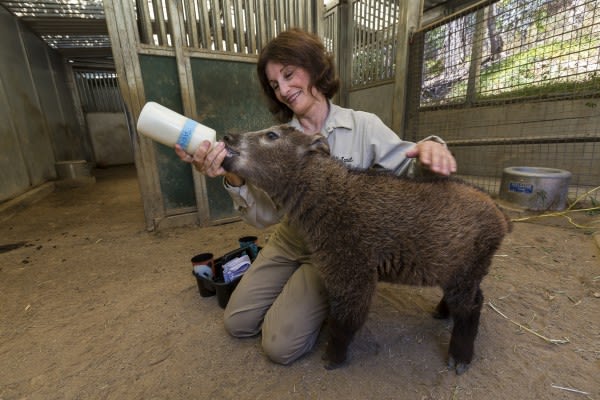amartineau
A 3-quart-a-day Baby!
A six-week-old female takin (pronounced “TAHK-in”) calf is currently being bottle-fed three times a day by animal care staff at the San Diego Zoo’s Neonatal Assisted Care Unit. Hsi Hsi (pronounced “CEE-CEE”), which means “playful monkey” in Chinese, was born to first-time mom Duli on May 22. When the calf was born, Duli was attentive to her, however no nursing was observed. Nursery keepers were called in to assist with Hsi Hsi’s care and began bottle-feeding her several times a day. The Zoo’s assisted care feedings provide the calf with the nourishment she needs, while allowing her to remain with her herd. Her two aunties, named Mei and Eve, look out for her and teach her many important social skills she will need later in life. Hsi Hsi is gaining an average of 500 grams every day—almost 7 pounds per week—and now weighs 50 pounds. At 6 weeks old, she’s starting to sample solid foods, like pellets, hay and browse. She’s an incredibly agile climber, is very playful and likes to stand in the water and soak her hooves. “Hsi Hsi is very spunky and loves to ‘head butt’ her browse, the rocks and the walls of her enclosure—and yes, even her aunties from time to time,” said Joanne Mills, senior keeper, veterinary services. “The calf will probably be receiving bottle feedings for another 13 to 14 weeks, and she will be the one to let keepers know when she is ready to be weaned, probably sometime in September.” Takins, native to the Sichuan province in China, are listed as vulnerable in the Convention on International Trade in Endangered Species (CITES) status Appendix II, due to overhunting and habitat loss. Baby takins are born with a “natal coat,” darker than the adults, and have a distinctive white patch of fur above the forehead. The babies lose their little “unibrow” and their fur becomes lighter as they get older. Takins are excellent climbers, thanks to their unique split hooves, an adaptation that helps them move around easily in a rocky habitat. Gold-colored takins seem to have the horns of a wildebeest, the nose of a moose, and the body of a bison. With this birth, there have been 67 takins born at the San Diego Zoo, which has the most successful breeding program of Sichuan takins in the United States. The San Diego Zoo was the first zoo to exhibit Sichuan takins to the public and has had tremendous success with its takin breeding program. The Zoo has always kept a medium-size herd to maintain genetic diversity for breeding. As a result, many births have occurred. Bringing species back from the brink of extinction is the goal of San Diego Zoo Global. As a leader in conservation, the work of San Diego Zoo Global includes on-site wildlife conservation efforts (representing both plants and animals) at the San Diego Zoo, San Diego Zoo Safari Park, and San Diego Zoo Institute for Conservation Research, as well as international field programs on six continents. The work of these entities is inspiring children through the San Diego Zoo Kids network, reaching out through the internet and in children’s hospitals nationwide. The work of San Diego Zoo Global is made possible by the San Diego Zoo Global Wildlife Conservancy and is supported in part by the Foundation of San Diego Zoo Global.  Image Credit: Ken Bohn, San Diego Zoo photographer.
Image Credit: Ken Bohn, San Diego Zoo photographer.
 Image Credit: Ken Bohn, San Diego Zoo photographer.
Image Credit: Ken Bohn, San Diego Zoo photographer.